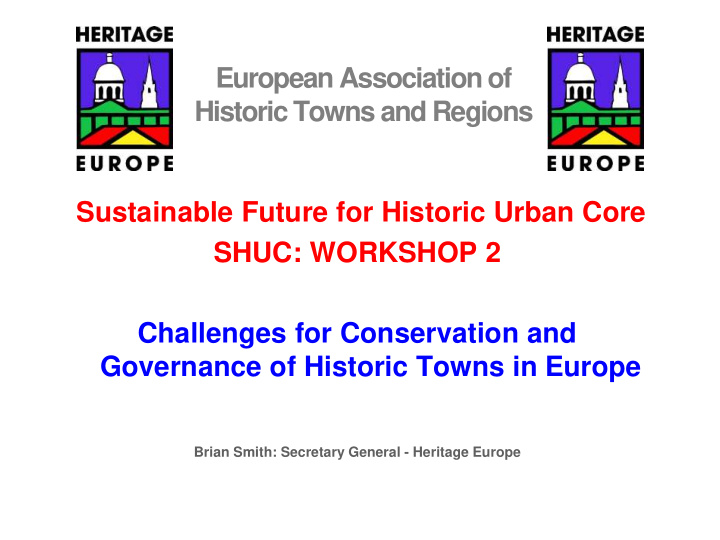



European Association of Historic Towns and Regions Sustainable Future for Historic Urban Core SHUC: WORKSHOP 2 Challenges for Conservation and Governance of Historic Towns in Europe Brian Smith: Secretary General - Heritage Europe
Introduction & context Heritage Europe created by Council of Europe in 1999 Historic towns models of sustainability – how are they adapting to current challenges? UK :Big or small government - last 25 years Outsourcing : shared services/ top management : focus on core services Cuts in size and role of local government Europe: Recession More cuts : reduced services, staff, skills and capacity as part of reducing deficit
Focus on growth and job creation: Europe 2020 – no mention of cultural heritage or historic cities Changed landscape-challenges & risks Reduced role for local government Less resources Fragmentation of service delivery Reinforcement of ‘silo’ management models Conservation, design and planning undervalued Impact of recession and banking crisis significant but there are post recession opportunities
Post Recession Opportunities Barroso Legacy Council of Ministers ‘Cultural Heritage as a strategic resource for Europe’ European Commission ‘ Towards an integrated approach to cultural heritage’ Horizon 2020- Cultural heritage research Mid Term review of Europe 2020 strategy Door opening to mainstreaming cultural heritage and access to European structural funds National and local governments need to focus on: - Smart, sustainable and inclusive growth/development
Conservation and Governance Cannot see conservation/cultural heritage in isolation from sustainable management of historic core Still need evidence of multiple benefits that accrue from investing in heritage Enhanced importance of cross cutting coordination to ensure policy alignment across range of delivery models Range of European experience to draw on e.g. INHERIT and HerO projects – integrated approaches at historic core and neighbourhood levels
Key issues Policy alignment - Heritage should be at heart of policy development in historic cities Europe, National, Regional, local governments NGOs, voluntary sector, public private partnerships Cultural heritage, cultural tourism, planning/ land use, green transport, mobility, logistics, health, air quality etc - mainstreaming Realisation of new economic opportunities Cultural tourism – seeing cultural heritage and its conservation and interpretation as the ‘product’ Building on role of historic core as incubator for creative industries and home for new clean manufacturing
Revisiting regulations and land use policy to allow adaptive re- use where possible Looking for innovative use of public private partnerships in heritage including mechanisms to de-risk investment Explore potential for social enterprise models that facilitate local community involvement in caring for and running heritage services. Ensure governance models embrace an integrated approach with full stakeholder/ community engagement
Conclusions Legacy of recession deep rooted and long lasting but new opportunities emerging Importance of heritage and conservation rediscovered as part of re-evaluation of core priorities New governance models likely to based on ‘soft’ measures capable of working in different circumstances – policy alignment, cross cutting coordination, stakeholder engagement SHUC – timely with the potential to contribute at the European, national and local levels
Recommend
More recommend